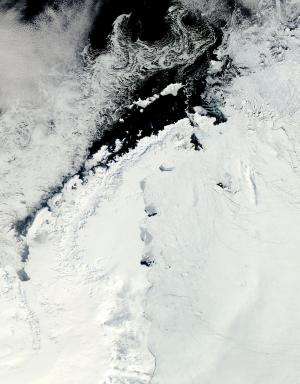January 10, 2014 report
Research trio offer new explanation for breakup of Larsen B Ice Shelf

(Phys.org) —A trio of researchers (two from the University of Chicago, the other from Princeton) has proposed a new theory to explain the sudden breakup of the Larsen B Ice Shelf in 2002. In their paper published in Geophysical Research Letters, Alison Banwell, Douglas MacAyeal and Olga Sergienko suggest that the breakup came about due to the sudden drainage of one surface lake causing others to drain leading to a chain reaction that ultimately led to the entire ice shelf being torn apart.
When Antarctica's Larsen B Ice Shelf (once roughly the size of Rhode Island) suddenly collapsed twelve years ago (over a two week period) many blamed global warming—prior to the collapse scientists had observed large stretches of surface water on the shelf, the result of warmer air—it was suggested that the surface water made its way down into crevices causing the shelf to break apart due to pressure from within. In this new effort, the researchers don't refute the claims of the ultimate cause of the collapse, i.e. global warming, but they do suggest it was a much more complicated process than most have assumed.
To gain a better understanding of what might have occurred, the researchers built a computer simulation to emulate the conditions that existed prior to the shelf collapsing. By adjusting multiple variables, the researchers say that it became clear that rather than surface water causing the collapse, it was more likely due to the sudden drainage of just a single lake. When that one lake drained, it caused other lakes nearby to drain, leading to a cascading event that resulted in virtually all of the lakes on the ice shelf draining in a very short period of time. The draining of the lakes led to chaotic stresses all across the shelf causing it to crumble and fall apart. Their theory is bolstered, the team says, by satellite observations just prior to the breakup that showed empty lakes all across the ice shelf.
The researchers are unable to explain why the first lake drained, though they suggest it might have been due to a process many years in the making, brought on by global warming. Warmer water under the shelf, for example, may have weekend its structure and perhaps eventually caused a hole to develop in the ice beneath one of the deeper lakes, allowing the lake water to seep through.
More information: Banwell, A. F., D. R. MacAyeal, and O. V. Sergienko (2013), Breakup of the Larsen B Ice Shelf triggered by chain reaction drainage of supraglacial lakes, Geophys. Res. Lett., 40, 5872–5876, DOI: 10.1002/2013GL057694
Abstract
The explosive disintegration of the Larsen B Ice Shelf poses two unresolved questions: What process (1) set a horizontal fracture spacing sufficiently small to predispose the subsequent ice shelf fragments to capsize and (2) synchronized the widespread drainage of >2750 supraglacial meltwater lakes observed in the days prior to break up? We answer both questions through analysis of the ice shelf's elastic flexure response to the supraglacial lakes on the ice shelf prior to break up. By expanding the previously articulated role of lakes beyond mere water reservoirs supporting hydrofracture, we show that lake-induced flexural stresses produce a fracture network with appropriate horizontal spacing to induce capsize-driven breakup. The analysis of flexural stresses suggests that drainage of a single lake can cause neighboring lakes to drain, which, in turn, causes farther removed lakes to drain. Such self-stimulating behavior can account for the sudden, widespread appearance of a fracture system capable of driving explosive break up.
Journal information: Geophysical Research Letters
© 2014 Phys.org

















